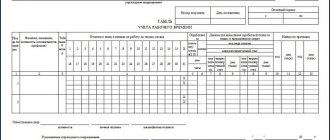Designations and codes in the time sheet
Leave without pay under the conditions provided for by the current legislation of the Russian Federation Annual additional leave without pay Temporary incapacity for work (except for cases provided for by code “T”) with the assignment of benefits, in accordance with the law Temporary incapacity for work without the assignment of benefits in cases provided for by law Shortened duration worker against the normal length of the working day in cases provided for by law Time of forced absence in case of recognition of dismissal, transfer to another job or suspension from work as illegal, with reinstatement to the previous job Absenteeism (absence from the workplace without good reason for the period established by law) Duration working part-time at the initiative of the employer in cases provided for by law Weekends (weekly vacation) and non-working holidays Additional days off (paid) Additional days off (without pay) Strike (under the conditions and in the manner prescribed by law) Absenteeism for unknown reasons (until the circumstances are clarified) Downtime due to the fault of the employer Downtime for reasons beyond the control of the employer and the employee downtime due to the fault of the employee Suspension from work (preclusion from work) with payment (benefits) in accordance with the law Suspension from work (preclusion from work) to work) for reasons provided for by law, without calculating wages, suspension of work in case of delay in payment of wages Unified form T-12 It should be noted that the unified form T-12 can be used in any organization, regardless of the form of ownership, except for budgetary institutions.
Question: How to mark night hours on the work time sheet if the employee works according to the schedule - every other day, he has been assigned a summarized recording of working time, a shift from until the next day?
(Expert consultation, 2010)
Remuneration for summarized accounting of working hours - examples of calculation
As a general rule, when considering time worked, a time-based wage system is used. There are two commonly used payroll calculation methods:
- The base value is the monthly official salary;
- The base rate is the hourly tariff rate.
The method of calculating the amount of wages, when the salary is taken as the base value, is convenient for an accounting period of 1 month. As you know, the salary is set for performing work during a month of normal working hours. Within an accounting period equal to a month, the time worked for each working week may be more or less than the established norm of 40 hours (in general), but in general, during the accounting period, the total duration of work performed corresponds to the norm of hours according to the production calendar of that month.
When the duration of the accounting period is more or less than one month, using the salary calculation method based on the monthly salary is inconvenient and incorrect. If the reference period is, for example, several months, the length of working time is very likely to differ from normal in each month. But in general, during the period under review, the duration of working hours actually worked is equal to the norm. If salary is taken as the basis of calculation, then a situation arises where remuneration for labor in the same identical amount, equal to the salary, is paid for a different amount of labor, which is proportional to the amount of working time.
Therefore, to calculate wages for an accounting period other than a month, the hourly tariff rate is used. It is calculated based on the normal (according to the production calendar) number of hours in a particular month or year, subject to a 5-day working week (Order of the Ministry of Health and Social Development of the Russian Federation dated August 13, 2009 No. 588n).
As an example, let’s calculate the standard working time for a 5-day, 40-hour week in June 2020, which has 21 working days:
40 : 5 × 21 – 1 = 167,
where “-1” is a 1-hour reduction in the working day on the pre-holiday June 11th.
The norm in June will be 167 working hours.
The standard working time for the year is calculated similarly . In 2020 this is 1979 hours. When using the annual working time indicator to calculate the average monthly rate, we obtain:
1,979 hours: 12 = 164.92 hours, i.e. the monthly rate in June (as in any other month) will be 164.92.
Summarized accounting of working time - examples of calculating wages from an hourly rate calculated at (1) the standard monthly working time and (2) the average monthly standard for the year are given below.
The salary is 40,000 rubles per month. The work schedule is shifts with summarized recording of working hours, the recording period is 2 months. The standard working time for the accounting period (May and June 2020) is 302 hours: May - 135 hours, June - 167. In May of the year 115 hours were worked, in June - 172. We calculate wages.
- When using the monthly working time standard:
May 2020 - 40,000: 135 × 129 = 38,222.22 rubles.
June 2020 - 40,000: 167 × 173 = 41,437.13 rubles.
- When using the annual working time standard:
May 2020 - 40,000: (1,979 / 12) × 129 = RUB 31,288.53
June 2020 - 40,000: (1,979 / 12) × 173 = 41,960.59 rub.
The rules for calculating the hourly rate for the purposes of calculating wages are determined by the employer and must be recorded in the local regulatory legal acts. This is mandatory because different calculation methods give different results for the amount of income an employee receives in a particular month.
It seems appropriate to set an hourly rate calculated on the basis of the monthly norm for an accounting period other than 1 month, but less than 1 year, and for an annual accounting period - an hourly rate calculated on the basis of the annual working time norm.
As for the payment of overtime work when recording working hours in aggregate, such a mechanism is not defined by the legislation of the Russian Federation. K+ experts cited the opinion of the Russian Ministry of Health and Social Development, as well as the Supreme Court of the Russian Federation. Get trial access to the system for free and proceed to the explanations.
How to get people to work at night and record night hours on a timesheet
Night time is the performance of work duties from 10 p.m. to 6 a.m., as defined by Article 96 of the Labor Code of the Russian Federation. How to correctly enter night hours on a time sheet in 2020 if the employee works on a shift schedule
?
Download documents on the topic:
It is necessary to take into account that the duration of a shift when working at night is one hour less than when performing work duties during the day. An exception is employees working on a shortened day or employees hired to perform work duties at night (Part 3 of Article 96 of the Labor Code of the Russian Federation).
Going to work on a night off, what to put in a report card – Legalists
In accordance with the law, all employees except representatives of certain categories have the right to work at night. These categories are specifically defined and may fall into one of two groups:
- persons who can work at night only if they have given written consent to this;
- and persons who cannot work at night at all.
Regarding persons for whom such a possibility exists, but only with their consent, it is established that this work should not be prohibited for them by a doctor’s conclusion due to their state of health. In addition, it is prescribed that such employees must first be made aware of the opportunity available to them to refuse to work at night.
It is worth noting that the familiarization of employees and their consent within the meaning of the law are different written documents, and both of them must be drawn up.
First, the employee is informed in writing of his right to refuse night hours, which he must sign. Then he also formalizes written consent to work at this time. This category includes:
- disabled people (since there is no specification in the law, this includes disabled people of all three groups);
- employees whose children have disabilities (also of any group, in addition, there is no stipulation that the children must be minors);
- women who have children under three years of age;
- mothers or single fathers whose children are under five years old;
- also guardians whose children are under five years of age.
It is absolutely unacceptable for pregnant women to go out at night. Another category for which this rule is established is minor employees. However, the Labor Code has provisions for them, according to which they can work at night:
- persons under 18 years of age taking part in the performance of works of art (we are talking about minor actors);
- other categories of such workers in accordance with Russian legislation.
Unified form N T-13 (filling sample)
Time sheet. Flexible schedule. Unified form N T-13 (filling sample)
Time sheet. Additional leave in connection with training without pay. Unified form N T-13 (filling sample)
Time sheet. Additional leave in connection with training while maintaining average earnings for employees combining work with training. Unified form N T-13 (filling sample)
Time sheet. Solid filling method. Unified form N T-13 (filling sample)
Time sheet. Method of accounting for deviations. Unified form N T-13 (filling sample)
Time sheet. Part-time training. Unified form N T-13 (filling sample)
Time sheet. Recycling on the pre-holiday day. Unified form N T-13 (filling sample)
Time sheet. Advanced training with a break from work in another area. Unified form N T-13 (filling sample)
Time sheet. Advanced training while away from work. Unified form N T-13 (filling sample)
Time sheet. Night work. Unified form N T-13 (filling sample)
Time sheet. Dividing the working day into parts. Unified form N T-13 (filling sample)
Time sheet. Part-time working hours. Unified form N T-13 (filling sample)
Time sheet. Overtime work. Unified form N T-13 (filling sample)
Time sheet. Shift work. Unified form N T-13 (filling sample)
Time sheet. Reduced working hours. Unified form N T-13 (filling sample)
Time sheet. Summarized working time recording. Unified form N T-13 (filling sample)
Pages:12
Night time is the performance of work duties from 10 p.m. to 6 a.m., as defined by Article 96 of the Labor Code of the Russian Federation. How to correctly enter night hours on a time sheet in 2020 if an employee works on a shift schedule?
How to fill out a time sheet with night hours in 2019
To fill out a work time sheet with night hours in 2019, a unified form No. T-12, No. T-13 or a document developed in the organization is used. Letter and numeric codes indicate the type of working time:
For example, when reporting to work during the day, the letter code “I” or the numeric “01” is entered. The line below indicates the exact number of hours worked by the employee that day. If work is performed at night, the code “H” or “02” is entered on the report card.
Conventions used to fill out a time sheet:
Note! The employer has the right to develop an individual form of a working time sheet, as well as introduce additional codes, in particular such as entering night hours in the working time sheet.
Order on the use of new symbols in the time sheet
In accordance with current legislation, it is allowed to fill out the timesheet using the continuous method, putting down the appropriate codes in letters or numbers for each calendar day.
In the second option, it is proposed to enter only deviations from the normal operating mode into the timesheet. If within one organization a shift work schedule
, to account for night hours in 2020, it is rational to use the continuous registration method.
Filling out a time sheet: night hours
Let's look in detail at how to enter night hours on the work time sheet in 2020. Despite the fact that each employer has the right to develop and approve its own report card form and conventional code designations in the form of letters or numbers, we will consider the option of how to correctly draw up a report card approved by the State Statistics Committee.
It is worth considering that night hours in document form No. T-12 are indicated in columns 4-6. In the unified form No. T-13, only the fourth column is provided for entering codes.
If an employee worked at night, defined from 22 to 6 o’clock, the letter code “H” is entered in the corresponding cell or the digital code “02” is used. The exact time indicated in hours and minutes is entered in the bottom line.
How to put day and night hours on a timesheet
At the same time, the watchman worked a total of 7 hours and 30 minutes during his shift. Work on a holiday at night only covers the period of work from 00.00 to 06.00, and the rest of the time (from 06.00 to 07.30) falls on work on a holiday during the day.
In accordance with the Instructions, the duration of work at night is indicated in the report card with the code “N” or “02”, and the duration of work on weekends and non-working holidays with the code “РВ” or “03”. The number of hours and minutes worked by the employee is entered in the bottom line.
Since the employee worked part of a daytime shift lasting 1 hour 30 minutes, the timesheet can be entered as 1.30 or 1.5 hours (either option is allowed).
At the same time, no special designations are provided to reflect day and night work on weekends and holidays in the timesheet.
According to Part 4 of Art. 91 of the Labor Code of the Russian Federation, the employer is obliged to keep records of the time actually worked by each employee, for which a working time sheet is used. In this case, the employer can use report card forms No. T-12, No. T-13 (approved.
Resolution of the State Statistics Committee of Russia dated January 5, 2004 No. 1) or independently develop your own form of report card. If an organization develops its own report card form, it must also determine the procedure for filling it out.
If an organization uses a report card in forms No. T-12, No. T-13, then when filling it out you must be guided by the Instructions for filling them out.
It follows from the Instructions that the duration of an employee’s work on a specific day is indicated on the timesheet in hours and minutes, that is, the actual number of hours and minutes that the employee worked must be indicated. According to Part 1 of Art. 96 of the Labor Code of the Russian Federation, night time is the time from 22 o’clock to 6 o’clock.
Special cases - filling out a time sheet: night hours.
More often in practice there are situations in which it is necessary to take into account part of the working time that falls at night. Employees working on a shift schedule are at work from 20.00 to 8 am or perform work duties every other day.
With such options, the period worked during the day and night is indicated in the time sheet, using the appropriate letter or numeric code designations.
The employee has a work schedule of every three days. He starts work duties at 20.00 in the evening and leaves at 8.00 in the morning. Daytime falls between 8:00 am and 10:00 pm and from 6:00 am to 8:00 am. Accordingly, during the daytime the employee works 16 hours, at night - 8 hours, divided into two working days. The responsible employee needs to know how to enter night hours in the work time sheet of the unified form No. T-13. In the columns of days worked, two fractional alphabetic or numeric codes are entered: “Y/N”. The bottom line indicates the number of hours worked per day and night: “14/2”, “2/6”.
Time sheet (night hours, sample 2019)
You can set daytime and nighttime hours separately, without using standard fractional notations. To do this, use separate lines, adding them to a unified form. And when developing an individual form for recording working time, it is immediately taken into account that you will have to record not only work during the day, but also at night.
Who is responsible for recording time worked in the organization?
According to the instructions for using and filling out forms of primary accounting documents:
- the work time sheet for 2020 is compiled and maintained by an authorized person;
- the document is signed by the head of the department and the HR employee;
- after which it is transferred to the accounting department.
As we can see, the rules do not establish the position of the employee who uses the time sheet form. Management has the right to appoint anyone to perform this task. To do this, an order is issued indicating the position and name of the responsible person. If an order appointing such an employee is not issued, then the obligation to keep records must be specified in the employment contract. Otherwise, it is unlawful to require an employee to keep records. In large organizations, such an employee is appointed in each department. He fills out the form within a month, gives it to the head of the department for signature, who, in turn, checks the data and passes the form to the personnel officer. The HR department employee verifies the information, fills out the documents necessary for his work based on it, signs the time sheet and passes it on to the accountant.
Time off on the report card
Important! We note one more detail that often eludes workers. If they chose time off for the time worked, they should still receive compensation in addition to their salary for going to work. It will coincide with one day's wages (not double). How to indicate time off on a time sheet A time sheet is a document that, according to the Labor Code of our country, should be maintained by any organization, even with a small staff.
How are working hours recorded?
The accounting sheet can be maintained in 2 ways - electronic or printed. In the first case, the unified T-13 form is used, in the second - T-12.
It is important to note that when drawing up a timesheet as the first option, it contains additional columns for calculating employee wages.
Important! A working time recording form must be present in every company, regardless of its type of activity.
It contains information about the attendance of working citizens at the workplace, as well as the facts of their absence and time off.
If an employee was not at work on any day, the time sheet will indicate the reason why this event occurred.
Information about business trips, all types of vacations, time off granted, and production downtime is also noted. In addition, it contains information about periods of temporary disability of citizens and time spent on maternity leave.
To indicate each specific circumstance, generally accepted symbols and codes are used, the explanations of which are indicated on the title page of the T-12 form.
What codes are indicated in the T-12 form?
Form T-12 involves the use of unified symbols and codes in the form of numbers and letters. The specified encoding is intended for all types of organizations, except government agencies . The codes can be found on the title form of the T-12 form.
According to this form, overtime work is indicated by code 04 or the letter C.
During the day:
Regular daytime work is designated by code 01 or the letter Y, overtime hours by the designation 04 or C.
On holidays and weekends, codes 03 or РВ are displayed.
At night time:
The involvement of an employee on the night shift is marked with the number 02 or the letter N.
Private organizations use both digital and alphabetic designations; each business entity chooses a reporting form that is convenient for itself.
Some organizations draw up their own form of report card; this is not prohibited by law; however, the use of unified codes is more familiar and understandable to regulatory authorities.
Overtime duration
Normal working hours are 40 hours per week (Article 91 of the Labor Code of the Russian Federation). The duration of overtime work should not exceed four hours for each employee for two days in a row and 120 hours per year (Part 6 of Article 99 of the Labor Code of the Russian Federation).
Tip one: reflect the time worked overtime by the employee in the working time sheet (for example, in form N T-12 or N T-13, approved by Resolution of the State Statistics Committee of Russia dated January 5, 2004 N 1).
It is the employer's responsibility to ensure that each employee's overtime hours are accurately recorded.
Mark overtime hours on the timesheet with the letter code “C” or the number “04”, under which the number of overtime hours is indicated.
True, for some categories of workers, a reduced working time is established, which is normal for them (Article 92 of the Labor Code of the Russian Federation). These include, in particular:
- minor workers - from 24 to 35 hours per week depending on age;
- disabled people of group I or II - no more than 35 hours per week;
- employees whose working conditions at their workplaces, based on the results of a special assessment of working conditions, are classified as hazardous working conditions of the 3rd or 4th degree or hazardous working conditions - no more than 36 hours per week;
- women working in the Far North (Article 320 of the Labor Code of the Russian Federation);
- teachers (Article 333 of the Labor Code of the Russian Federation);
- health workers (Article 350 of the Labor Code of the Russian Federation).
That is, for these categories of workers, overtime will be considered work that exceeds the reduced working hours established for them (daily work, shift).
The rules regarding overtime work apply to both employees at the main place of work and part-time workers.
Who should not be required to work overtime?
It is prohibited to engage the following employees in overtime work:
- pregnant women (Part 5 of Article 99 of the Labor Code of the Russian Federation);
- persons under 18 years of age,
The exceptions are:
- certain categories of creative workers (Article 268 of the Labor Code of the Russian Federation). Their List was approved by Decree of the Government of the Russian Federation of April 28, 2007 N 252;
- athletes, if a collective or labor agreement, agreements, or local regulations establish the cases and procedure for engaging in overtime work (Part 3 of Article 348.8 of the Labor Code of the Russian Federation);
- employees during the period of validity of the apprenticeship contract (Part 3 of Article 203 of the Labor Code of the Russian Federation);
- other employees (as a rule, restrictions are established due to medical contraindications, for example, for persons with an active form of tuberculosis - Resolution of the Council of People's Commissars of the USSR of 01/05/1943 N 15; drivers allowed to drive a vehicle as an exception due to a special health condition - Sanitary rules on occupational hygiene for car drivers, approved by the USSR Ministry of Health on May 05, 1988 N 4616-88).
In addition, for some categories of employees there is a special procedure for attracting overtime work. The employer is obliged:
- obtain the employee’s written consent;
- make sure there are no medical contraindications;
- familiarize employees with the right to refuse overtime work upon signature.
Such employees include (Part 5 of Article 99, Article 259, Article 264 of the Labor Code of the Russian Federation):
- disabled people;
- women with children under three years of age;
- mothers and fathers raising children under the age of five without a spouse;
- workers with disabled children;
- workers caring for sick members of their families in accordance with a medical report;
- guardians (trustees) of minors.
How to count night hours on a time sheet
An exception is employees working on a shortened day or employees hired to perform work duties at night (Part 3 of Article 96 of the Labor Code of the Russian Federation). Read more about the time sheet here: Please note! Underage employees and pregnant women should not be hired to work the night shift. The exception is creative professions and participation in various artistic performances. Time sheets - how to enter night time sheets? Important Conventions used to fill out a time sheet: Please note! The employer has the right to develop an individual form of a working time sheet, as well as introduce additional codes, in particular such as entering night hours in the working time sheet.
Parental leave and part-time work
At the request of a mother (another relative or guardian caring for a child) who is on maternity leave, the employer may allow her to work part-time. In such a situation, the timesheet must reflect both care leave and time worked. In the report card, care leave is reflected by the letter code “OZH” or the number “15”; the column under the code is not filled in.
How to reflect time off on a time sheet?
In this case, remuneration is regulated by the Labor Code on employee rest days and non-working days (including holidays), as follows: a double payment is accrued or a calculation is made for one calendar day with a second day for rest. An employee, according to legislative norms, has the right to independently choose one of two forms of payment. The HR specialist will subsequently indicate the time off on the time sheet for subsequent correct calculation of wages.
The employer is prohibited from exerting pressure and imposing one of the listed solutions , with the exception of situations where employees are employed under a fixed-term contract lasting less than two months. In this case, work on weekends can only be compensated with double pay.
Labor legislation provides for the use of workers on rest days only in the presence of emergency situations, when it is necessary to resolve unplanned issues for the further normal functioning of the company. An additional day of rest is allocated by the manager for previously worked time to an employee who has fulfilled his work obligations on a holiday or his day off.
Grounds for granting time off, according to the Labor Code:
- Overtime worked (152);
- Working on a day of rest or a holiday ( 153 ). By the way, you can read more about this in the material about Article 153 of the Labor Code of the Russian Federation “wages on weekends and non-working holidays”;
- Reworking hours within the previously drawn up schedule during shift work (301);
- Donating blood (186).
How is time off indicated on the time sheet?
According to the Labor Code of the Russian Federation, it is customary to display the designation of time off on the working time sheet, in accordance with strict reporting of actual hours worked. This document systematizes data on the working hours of employees, including the days they missed (sick leave, days off or vacation), and work outside of normal working hours.
The timesheet serves as the basis for calculations and accruals of labor payments; according to the data in it, reports are drawn up and audits are carried out.
How to enter night hours on a timesheet in 2017
In three days: how to register and pay for shift work? Expert advice from Alexander IONOCHKIN, head of the department of federal state supervision No. 3 of State Labor Inspectorate in Moscow. Establish a summarized accounting of working hours if you use sliding schedules. Popular questions When working a week with days off on a sliding schedule, it is necessary to establish a summarized accounting of working hours (Article 104 of the Labor Code of the Russian Federation) . This is due to the fact that with a staggered work schedule, for example “two to two”, it is not possible to provide the employee with the normal duration of daily or weekly work.
How to count night hours on a time sheet
How to correctly reflect “night” hours on a timesheet? In the process of creating a schedule, HR employees monitor compliance with the following conditions:
- rest per week must be at least 48 hours;
- lunch break can vary from 30 minutes to 2 hours;
- the possibility of working several shifts in a row is excluded;
- it is necessary to take into account annual leave, which lasts on average 28 calendar days.
Nuances of introduction The work schedule must fully comply with the time standard for a certain accounting period. We keep total records of working time correctly. The longer the accounting period the employer chooses, the more chances he will have to avoid violating work and rest standards. Set the deadline for employees to familiarize themselves with the staggered schedule in a local regulation or directly in their employment contracts.
How to correctly reflect “night” hours on a timesheet?
And from which hours should we remove the break hour from the timesheet to make it 11 o'clock in the end? And how can this be correctly displayed on the timesheet? Typically, the employee is given time to eat 4 hours after the start of the shift. in your case, on the night shift from 00.00 to 01.00, it is fashionable to display in the timesheet as follows “No. day “Shift No./7” total 7 hours including 5 hours at night. PS During the night shift there is no way to remove “non-night” hours from eating)) Password is someone else’s computer Forgot your password? © 1997 - 2020 PPT.RUFull or partial copying of materials is prohibited; with agreed copying, a link to the resource is required. Your personal data is processed on the site for the purpose of its functioning within the framework of the Policy regarding the processing of personal data. Advice from expert Alexander IONOCHKIN, head of the department of federal state supervision No. 3 of the GIT in the city of Moscow Establish a summarized accounting of working hours if you use sliding schedules During a working week with the provision of days off according to a sliding schedule, it is necessary to establish a summarized accounting of working hours (Article 104 of the Labor Code of the Russian Federation). This is due to the fact that with a staggered work schedule, for example “two to two”, it is not possible to provide the employee with the normal duration of daily or weekly work. Therefore, the employer must ensure that the normal number of working hours is observed for the selected accounting period (month, quarter, etc., but not more than a year). It must be remembered that for certain categories of employees the legislation establishes a special duration of the accounting period (Part two of Article 104 of the Labor Code of the Russian Federation).
How to correctly indicate the hours of a guard's shift on a time sheet
“But if the company conducts settlements with personnel as a separate type of accounting, section 2 simply remains empty. There are two ways to fill out a timesheet: complete filling - all appearances and absences are noted every day; filling in by deviations - only lateness and no-shows are noted. The head of the department (an 8-hour working day was established) in the period from 06/19/2020 to 06/30/2020 was on annual paid leave. The accountant (an 8-hour working day was established) was on a business trip from 06/13/2020 to 06/16/2020, and worked the remaining days in full.
The teacher (working on a 2/2 schedule for 12 hours per day shift) was granted leave for family reasons without pay during the period from 06/05/2020 to 06/06/2020, the rest of the time he worked in full.
Fill out a fragment of the report card (f.
And they are not provided for in the staffing table. Article 154 also does not characterize increased pay for night work as an allowance, like the government decree mentioned above. However, Article 129, which deciphers the concepts of payments related to compensation, says that they include, in particular, additional payments and allowances for work in conditions that do not correspond to the norm.
We recommend reading: Rko and pko forms
Working at night may be considered deviant. From this it follows that their payment, recorded in the staffing table as a type of allowance, does not conflict with the law. You can also apply different logic than the one outlined.
Note! Based on Article 154 of the Labor Code of the Russian Federation, work performed at night is subject to increased wage payment.
How to count night hours on a time sheet
Themes:
- Work time
- Time sheet
- Night work
- how to attract to work at night and record night hours in the time sheet;
- how to fill out a time sheet with night hours in 2017;
- What are the restrictions for night work?
A personnel officer needs to know how to enter night hours on a time sheet in 2020, taking into account current labor legislation. If it is necessary to involve employees in working at night, it is recommended that special documentation procedures be taken into account and followed. From the article you will learn:
Statement of employee’s consent to work at night Download in .doc How to attract to work at night and record night hours in the report card Night time is the performance of work duties from 22 to 6 o’clock, as defined by Article 96 of the Labor Code of the Russian Federation.
How to write a “every two days” schedule in an employment contract? Attention: If the schedule for an employee differs from the general rules established by a given employer, the elements of the regime are also fixed in the employment contract (paragraph 6, part two, article 57, part one, article 100, part three, article 104 of the Labor Code of the Russian Federation). Important article on the website: “Summary accounting: bypassing the difficulties of implementation” If previously the organization or some of its employees worked differently, then a new mode of operation can be introduced by agreement of the parties (Article 72 of the Labor Code of the Russian Federation) or in connection with a change in organizational or technological conditions labor (Article 74 of the Labor Code of the Russian Federation). In the first case, additional agreements to employment contracts can be immediately concluded with employees. If the changes are related to changes in working conditions, employees must be notified of the transition to a new work schedule in writing at least two months in advance (part two of Article 74 of the Labor Code of the Russian Federation).
Overtime pay for night work
Article 95 of the Labor Code of the Russian Federation
According to part one of Art. 95 of the Labor Code of the Russian Federation, the duration of the working day or shift immediately preceding a non-working holiday is reduced by 1 hour. This norm applies to all employees, regardless of the length of the working week established for them, which was confirmed by the Supreme Court of the Russian Federation in decision dated September 29, 2006 N GKPI06-963. This means that the duration of work on the eve of a holiday should be 1 hour less than usual, including for part-time workers, as well as people with part-time or reduced working hours.
Overtime compensation
In continuously operating organizations and in certain types of work where it is impossible to reduce the duration of work (shift) on a pre-holiday day, overtime is compensated by providing the employee with additional rest time or, with the consent of the employee, payment according to the standards established for overtime work (part two of Article 95 of the Labor Code RF). Accordingly, in such a situation, an hour of overtime must be compensated by providing the employee with additional rest time, or the employee may agree with the employer’s offer to pay for overtime work.
Overtime work is paid for the first two hours of work at least one and a half times the rate, for subsequent hours - at least twice the rate. Specific amounts of payment for overtime work can be determined by a collective agreement, local regulations or an employment contract (Article 152 of the Labor Code of the Russian Federation).
Payment for night work
Work at night (from 22 o'clock to 6 o'clock) is paid at an increased rate (every hour of work at night) (part one of Article 154 of the Labor Code of the Russian Federation). The minimum increase is established by Decree of the Government of the Russian Federation dated July 22, 2008 N 554 and is 20% of the hourly tariff rate (salary calculated per hour of work) for each hour of work at night. The specific amounts of increased wages for work at night are established by a collective agreement, a local regulatory act adopted taking into account the opinion of the representative body of workers, and an employment contract (part three of Article 154 of the Labor Code of the Russian Federation).
However, the rules for overtime pay do not cancel the rules for increased pay for night work. Article 154 of the Labor Code of the Russian Federation applies to any night work performed both during working hours and outside it (overtime, on weekends and non-working holidays). Therefore, for an employee who worked overtime at night, the employer is obliged to make two compensation payments simultaneously - under Art. 152 and under Art. 154 Labor Code of the Russian Federation.
Thus, an hour of overtime on a pre-holiday day that falls at night is subject to payment simultaneously both as overtime work (Article 152 of the Labor Code of the Russian Federation) and as work at night (Article 154 of the Labor Code of the Russian Federation). Moreover, both of these compensations are provided independently, independently of each other (see, for example, the decision of the Neryungri City Court of the Republic of Sakha (Yakutia) dated July 15, 2010 in case No. 2-1315-2010).








